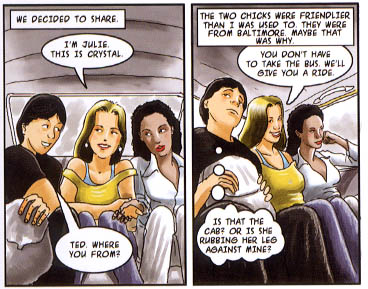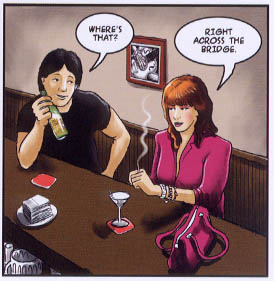 Written by Ted Rall
Written by Ted Rall
Art by Pablo G. Callejo
128 pages, color
Published by NBM
Ted Rall is probably best known for his political cartoons, and his travel journalism in books like Silk Road to Ruin. When I think of Rall, though, one of the works that always jumps to my mind is his autobiographical My War With Brian. That’s probably why I was intrigued when NBM first announced Rall’s autobiographical The Year of Loving Dangerously; Rall wasn’t afraid to lay out his past in an unflattering way based on My War With Brian, and Rall’s new book promised to do just that. What I found, though, was a book that gets oddly defensive in places that you’d have expected otherwise.
 The Year of Loving Dangerously explains what happened to Rall when, due to a medical situation, he ended up getting expelled from Columbia University’s engineering department after his junior year. Suddenly without a place to live or an income, he finds himself homeless, and that’s when he discovers a whole new way to "couch surf." Thus begins Rall’s pattern of hooking up with numerous women, in part so he can stay at their home overnight and have a bed to sleep in. It’s a premise that makes you wonder why film directors haven’t already co-opted it (Rall should contact Seth Rogen right now), although to be fair The Year of Loving Dangerously really isn’t a comedy. Instead it’s a story about someone struggling to survive in a bad situation the best he can.
The Year of Loving Dangerously explains what happened to Rall when, due to a medical situation, he ended up getting expelled from Columbia University’s engineering department after his junior year. Suddenly without a place to live or an income, he finds himself homeless, and that’s when he discovers a whole new way to "couch surf." Thus begins Rall’s pattern of hooking up with numerous women, in part so he can stay at their home overnight and have a bed to sleep in. It’s a premise that makes you wonder why film directors haven’t already co-opted it (Rall should contact Seth Rogen right now), although to be fair The Year of Loving Dangerously really isn’t a comedy. Instead it’s a story about someone struggling to survive in a bad situation the best he can.
One thing you pick up very quickly is that The Year of Loving Dangerously is in some ways less a straight forward story, and more a series of justifications for past actions. Some of them make perfect sense; when you have no money and nowhere to stay, you’re willing to lower your standards and do what you have to. Selling signs that were slated to be thrown out by MTA? Perfectly understandable. Stealing electric typewriters from Columbia? That’s where things start to get hazier; it’s certainly not a "good" thing to do, although many people can look back into their youth and find similar, full-of-rage moments that seemed like a good idea at the time. What gets odd, though, is when Rall tells the story of a trip into Massachusetts where he and his friend Chris are taking unauthorized side trips while delivering a car. After getting pulled over while driving without lights on at night, and smoking a bong in the car, they briefly end up in jail and fleeced of their money. Rall ends the story with the comment, "The arrest wasn’t my fault." It’s a perplexing comment, because you look at the sequence of events and one thing is abundantly clear: it was his fault.
 From that point on, reading The Year of Loving Dangerously is a very different experience. When Rall-as-narrator speaks, you understand that what he’s saying versus what really happened might not be in perfect alignment. His perspective on the series of events puts him alternately as martyr and hero, with remarkably little blame ever landing at his own feet. (Only in hurling water balloons at passing cars from his dorm window does he truly admit guilt.) So while watching Rall’s struggles and dubious decisions continues to be interesting, it’s hard to not see the buck getting forever passed to other characters in the story. I’m actually all in favor of a story told using the literary device of the "unreliable narrator," but one gets the impression with The Year of Loving Dangerously that it wasn’t Rall’s intention.
From that point on, reading The Year of Loving Dangerously is a very different experience. When Rall-as-narrator speaks, you understand that what he’s saying versus what really happened might not be in perfect alignment. His perspective on the series of events puts him alternately as martyr and hero, with remarkably little blame ever landing at his own feet. (Only in hurling water balloons at passing cars from his dorm window does he truly admit guilt.) So while watching Rall’s struggles and dubious decisions continues to be interesting, it’s hard to not see the buck getting forever passed to other characters in the story. I’m actually all in favor of a story told using the literary device of the "unreliable narrator," but one gets the impression with The Year of Loving Dangerously that it wasn’t Rall’s intention.
Pablo G. Callejo’s art in The Year of Loving Dangerously is a treat from start to finish; he draws his characters with an innocent look, thanks to rounded faces and clean lines. Callejo draws the young Rall in a way that makes him both recognizably the cartoonist (for those who have seen or met him), but without feeling stiff, posed, or light boxed off of existing photographs. I think it’s Callejo’s art style that actually makes the book slightly more likable; Rall’s narration may not ever come across as warm, but his alter-ego on the page does in places.
The Year of Loving Dangerously is the sort of book that’s fun on the surface; the unapologetic nature of the story telling, the juggling of "relationships" that Rall holds down, the mishaps that he has with his friend Chris. It’s only when you start to think about the book that it takes on a different and slightly off-putting air. I think it’s a good story, but perhaps not the story that Rall entirely planned on telling. This is the kind of glimpse into someone’s life that readers rarely get.
Purchase Links: Amazon.com | Powell’s Books
